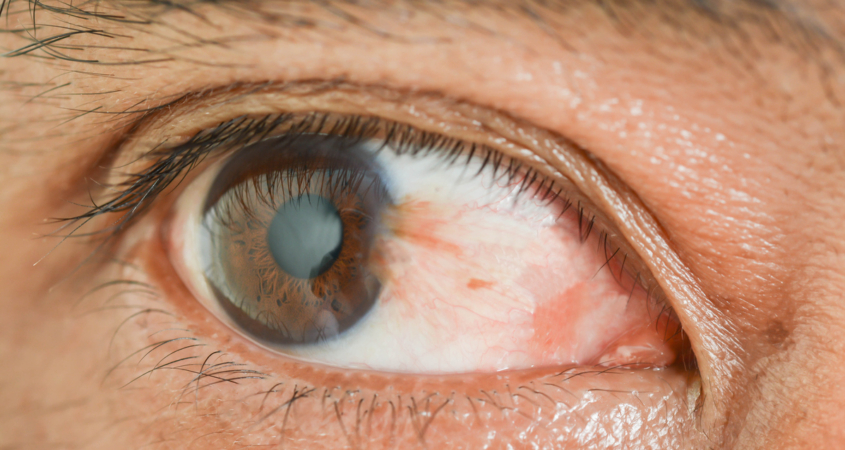How To Know if You Need Pterygium Removal Surgery
A pterygium (tuh-RIJ-ee-uhm) is an abnormal tissue growth filled with blood vessels on the conjunctiva, the transparent membrane covering the eye. It’s also known as surfer’s eye because factors such as UV exposure, getting sand in your eyes, and living in tropical or dusty environments increase the risk of developing this condition. Pterygium may look a little strange, but rest assured that it’s not cancer.
If you have been diagnosed with pterygium, it’s essential to begin treatment immediately. In mild cases, your eye doctor may recommend conservative treatments to manage pterygium without surgery. However, the only way to remove the growth entirely on your conjunctiva is to get pterygium surgery. Here are the factors that play into your decision to have your pterygium surgically removed.

Discomfort
Minor pterygium growth is usually treatable with artificial tears that improve lubrication and reduce redness and inflammation. However, itchiness, irritation, burning, grittiness, dry eyes, and the sensation that something is “in your eye” may persist in severe cases. If you experience constant discomfort despite taking over-the-counter medicine, you have a viable reason to consider pterygium surgery.
Corneal Distortion
Pterygium growth usually begins in the corner of the eye and slowly spreads toward the cornea, the clear surface on the front of the eye. If the pterygium extends onto the cornea, it may distort the shape of your eye and cause a condition called astigmatism. This imperfection of the corneal curve causes blurry vision and may prevent you from wearing your contact lenses. If your pterygium is starting to affect the shape of your cornea, surgical treatment should solve the problem.
Poor Vision
Mild pterygium doesn’t usually cause vision problems. Typically, the wedge-shaped growth only covers the white of the eye, or it may partially obscure the iris. With conservative treatment, pterygium often stops progressing at this point. However, if the pterygium grows, it may eventually cover the pupil. In addition to potentially distorting the cornea and causing astigmatism, this may lead to obstructed or double vision. If you begin experiencing visual disturbances because of pterygium, it’s time to consider surgery.
Cosmetic Reasons
Your eyes are one of the first things people notice about you. If you have a wedge-shaped growth covering the whites of your eyes and part of your irises, you might start feeling self-conscious about the way your eyes look. People may even make remarks or ask questions about your condition, making you even more insecure. Rest assured that pterygium surgery entirely removes the growth in your eyes, leaving you with an excellent cosmetic outcome.
What is the Recovery Time for Pterygium Surgery

The recovery time for pterygium surgery, especially with the ASAP™ method, is generally short. This is a minimally invasive surgery, which helps reduce both discomfort and healing time. Patients typically can return to their normal activities soon after the procedure. The surgical area quickly regains a normal appearance as the tissue glue used dissolves within about a week, allowing the eye to heal efficiently and minimizing disruption to daily life.
What Are The Chances of Pterygium Recurrence
The chance of pterygium recurrence after surgery is influenced by the surgical approach and post-operative care. Dr. Martinez has performed over 12,000 pterygium surgeries with superior patient outcomes and an incredibly low recurrence rate of less than 0.01%. These factors place Dr. Martinez among the top pterygium surgeons in the world.
To further minimize the risk of recurrent pterygium, it is crucial for patients to adopt preventive measures. Wearing sunglasses or a wide-brimmed hat to shield the eyes from UV exposure is recommended. Such precautions are essential, especially considering UV exposure is a significant factor in the development of primary pterygium. By adhering to these guidelines, patients can significantly reduce the likelihood of recurrence, ensuring the long-term success of the surgery.
Schedule Pterygium Removal Surgery at Visionary Eye Doctors

Our experienced ophthalmologist, Dr. J. Alberto Martinez, treats pterygium with Advanced Sutureless Amniotic Membrane Pterygiectomy (ASAP™). The ASAP™ procedure uses an advanced autograft technique and tissue “glue” to deliver no-stitch pterygium surgery. It’s possible to place the tissue adhesive in mere seconds rather than taking minutes to apply stitches. An amniotic membrane is also placed in the eye to aid the healing process and decrease inflammation. The tissue adhesive dissolves in about a week, leaving no residue and allowing the eye to heal comfortably.
For more information about pterygium removal and other surgical procedure options, please contact Visionary Eye Doctors online or call us at (301) 591-1763. We have three offices in the DC area to better serve you.


